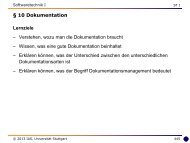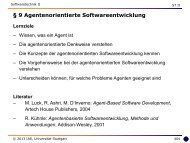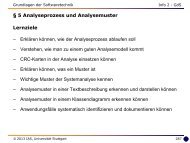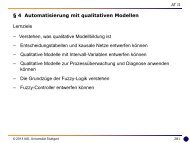Grundlagen FlexRay - Institut für Automatisierungs- und ...
Grundlagen FlexRay - Institut für Automatisierungs- und ...
Grundlagen FlexRay - Institut für Automatisierungs- und ...
Create successful ePaper yourself
Turn your PDF publications into a flip-book with our unique Google optimized e-Paper software.
<strong>Gr<strong>und</strong>lagen</strong> <strong>FlexRay</strong> BasicsV 1.1 35<br />
Figure 2.31 shows that the optional Symbol Window follows the dynamic segment. It can be<br />
used to send one Symbol per Cycle.<br />
The length gdSymbolWindow of the Symbol Windows can be defined between 0 and 142<br />
Macroticks. The Media Access Test Symbol (MTS) is used to check the Bus Guardian and is<br />
the only Symbol currently used. The length cdCAS of the Media Access Test Symbols is 30<br />
low bits, just like the one of the Collision Avoidance Symbol. The Collision Avoidance<br />
Symbol isn’t transmitted in the Symbol Window, but during the Startup oft he cluster.<br />
2.11.6 Network Idle Time<br />
Every communication cycle ends with the Network Idle Time. In this segment, the bus is<br />
silent, there is no communication.<br />
The Network Idle Time is used to synchronize the ECUS, and is defined by the parameter<br />
gdNIT (2 to 805 Macroticks). As seen in Figure 2.31, the Network Idle is divided in two parts.<br />
During Channel Idle (CI) the synchronization calculation is performed, and is adjusted in the<br />
Offset Correction Segment.<br />
2.12 Frame format<br />
A frame consists of three parts, header, payload, and trailer, see Figure 2.32.<br />
Figure 2.32 Structure of a Frames<br />
2.12.1 Header<br />
The first 40 bits of a frame are called header. It contains information which is necessary for<br />
the protocol.<br />
• Status Bits – at the start of a frame, the Reserved Bit, Payload Preamble Indicator,<br />
Null Frame Indicator, Sync Frame Indicator and Startup Frame Indicator are<br />
transmitted. The bits describe the type of payload transmitted. A detailed description is<br />
available in [FRPS05].<br />
Bäurle 12.10.2012
















